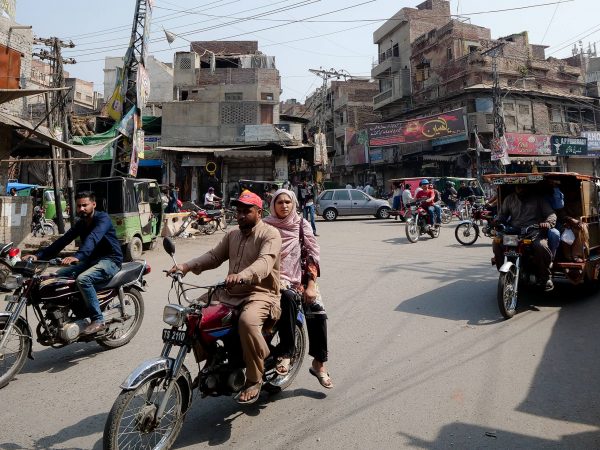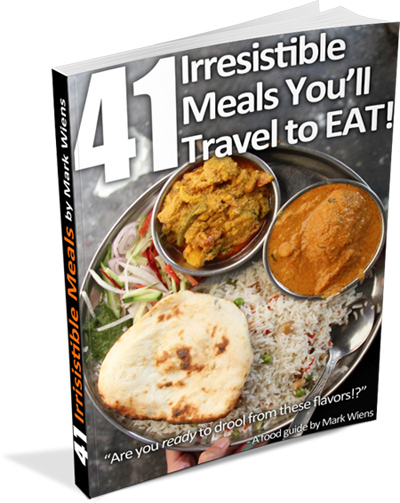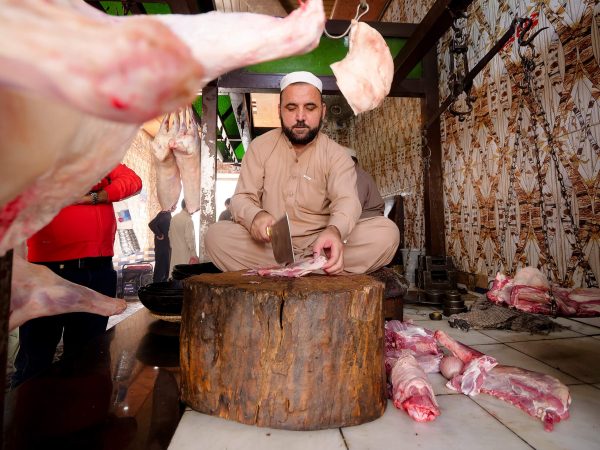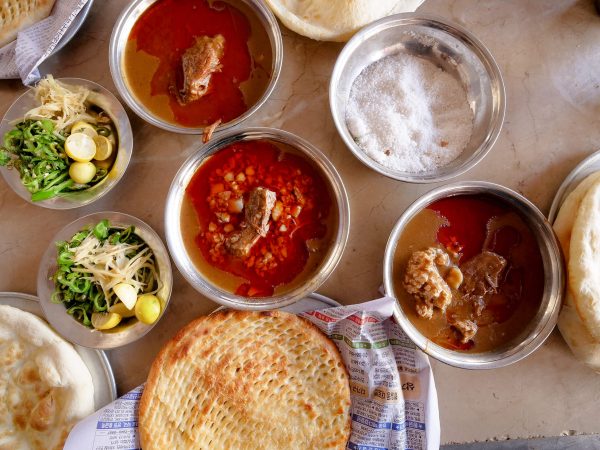
The Karakoram mountain region of Pakistan is an area of almost indescribable beauty.
When you visit Pakistan, I want to help you maximize this experience, and so we are creating this guide to help you do it.
For some of the best sights in Northern Pakistan, and all the authentic local flavors of the Karakoram mountains, scroll down now.

When you visit Pakistan, you have to plan a trip to its northern region of Baltistan. This area is not only full of natural beauty, it also has tons of amazing and unique food.
No itinerary for Pakistan is complete without a visit to the Karakoram mountains, and incredibly enough, you’ll start this trip in a truly amazing fashion – traveling the silk road route of ancient times.
The Silk Road of Ancient Times
The ancient Silk Road runs directly through Northern Pakistan.
Moving almost parallel down the ‘new’ Karakoram Highway, you’ll see both routes skirt their way across the Hunza River’s breath-taking steep valley walls.
The old road is visible for nearly your entire drive to the pass of Khunjerab, and what a way to excite the imagination of anyone brave enough to visit.
Incredible History of the Karakoram Range
Traveling on Pakistan’s Karakoram highway, you can watch as the old Silk Road route twists and climbs beside you. The scene is a harrowing and constant tribute to the incredible history of this place.
Video, and a Map: To get your bearings before we begin, here’s a quick Google maps view of the general area. Next, if you haven’t already, use this link here (Mark Wiens on YouTube), to watch a great video detailing all the sights, the sounds, and the flavors of our own visit to the Karakoram mountains.
Read on for more details!

Transportation for the Journey of a Lifetime
Fortunately for modern-day travelers like us, its a little easier to visit the Karakoram mountains than it was in years long ago.
You can even make this entire trip now in just 2 days time; head north from Islamabad (the capital of Pakistan), and drive onwards to Hunza (stop here to end day 1). Finally, press on to the Khunjerab pass (Pakistan China border, day 2) and either return again to Hunza (making a total trip of 3 days), or drive all the way back to Gilgit (keeping it to just 2).
I’ll leave a lot more number details at the bottom of this article for you, for now I’ll share more of the experiences of this journey.
First, You Need a Vehicle.
You will need a vehicle, and probably want a driver as well. I know that I was so thankful to not be the one behind the wheel this day.
To get the most out of your trip, you might want to fly from Islamabad, arrive in Gilgit town, and rent your vehicle there (driving from the capital is possible, but the drive time alone will be more than 24 hours, so doing it this way cuts that time in half, while still including all the highlights on the way).
Driving from Gilgit, to Karimabad, stop the first night in the Hunza Valley. A great way to acclimatize to the altitude, and also enjoy what might be the most beautiful place I have ever seen in my life. Wake up in the refreshing Hunza air, complete the Karakoram journey to Khunjerab on day 2.
Second, Your Stomach, Your Camera, and This Guide.
The route is full of attractions along the way, and whether you drive yourself, or come as part of a tour, this is going to be a few very full days, active from dawn to dusk, and extremely well worth your trip.
I’m sure it will be no wonder to you that this highway is often called the Eighth Wonder of the World, and all you need now is to prepare your stomach, your camera, and continue on using this guide.
Price Tip: Bartering for price is very common here, and its not disrespectful at all – spend some time and find a rental that makes you happy. To give you some idea for comparison on price, 30,000PKR per day is a good guess (3 full days of driving and touring makes 90,000PKR), and we had a comfortable and spacious Toyota Prado, and a private driver.

Day 1 – Begin Your Drive in Gilgit
When all your preparations are in order, there’s nothing but beautiful scenery, and some amazing meals close at hand. If you drive from Gilgit on day 1, you’ll have no trouble reaching Karimabad sometime in the early afternoon, so feel free to stop and enjoy all the snacks, and photograph the amazing scenery you see along the way.
Don’t miss eating ‘Chapshoro’ meat pies (link here), be on the lookout for local dry fruit – grapes, berries, and apples are amazing here (look for sour ‘queen apples’ as well!), and of course taking time for at least a few cups of dud pathi Pakistani milk tea.
On the Way, the Hunza Valley
The Hunza Valley is your first big stop, and sure to be one of the highlights of your trip (if you’re like me, then possibly even your lifetime!). We did a lot in Hunza actually, with so many details that it was easier to just make another entire article.
Check out the Migrationology article for Hunza, including activities and things to do in the town of Karimabad (link). Watch the video of our own first day’s drive here, and the amazing local food of Baltistan we had with a local family for dinner.
Get exclusive updates
Enter your email and I’ll send you the best travel food content.
Eagle’s Nest, and Mt. Rakaposhi
I am sure that you’re already loving both the clean air in this region, as well as any drink you find of the incredibly fresh ‘Hunza Water.’ To finish day 1, a mind-blowing view of the Karakoram range awaits, at a place called the “Eagle’s Nest” (be sure to arrive in Hunza at least 30 minutes before sunset for this treat).
Wake up in Hunza, have a local breakfast of ‘Gyal‘ and Tea, and catch an early morning view of the giant Mt. Rakaposhi.
Here finishes day 1, and begins your journey for day 2.
Hotel Tip: Stay at Serena Hotels in both Gilgit and in Karimabad (Hunza Valley) (the 1st and 4th nights in Gilgit, and the 2nd and 3rd nights in Hunza, traveling like we did on the Karakoram Highway route).

Day 2 – First Stop, Attabad Lake
The stunning beauty of Attabad Lake (sometimes ‘Atta Abad’) is the first stop of Day 2, beautiful, and yet also terrible, this incredible view came at a cost.
In the year 2010, a natural disaster was a catalyst for transportation development in this region. As recently as a decade ago (tunnels now provide safe passage), crossing Attabad lake meant lifting every single bit of cargo up and onto huge wooden boats, traversing truly incredible and yet freezing cold blue waters that fill this river valley.
Attabad Lake today though, seems so serene and calm amidst the towering gray rock faces of the Karakoram Range that surround it.
When the wind is gone, the lake surface color shines an incredible and vibrant blue color, its something you just have to see for yourself (video clip here (Mark Wiens on YouTube).
Boat Tour, and a Snack
A quick boat tour may be in order (see the price below), and afterwards, a cup of steaming ‘dud pathi‘ milk tea with hot roti cakes, or a huge egg omelette to share. There’s a large cafe near the car parking area, this is a great place to catch one more panoramic Attabad lake view before continuing on your way.
Location: Google Maps
Hours: All Daylight Hours
Price: Expect to pay around 2000PKR for the entire boat (can hold around 15 people)

Transition to Dream-Land
As the journey to the Khunjerab pass continues, the surroundings will begin to look less like the world we know, and more like those landing documentaries from NASA’s most recent mission to Mars.
The definition in the jags and rock faces, cracks and crevasses pushing up thousands of metres of wind-swept rock, is magnificent, its incredible, I think really only a poet could do any description here true justice.
Local Tip: As the elevation increases though, air pressure (and oxygen) will decrease. Be sure to drink water, walk slowly, and snack on dry fruit while you drive. Locals swear by the apricots, as they may prevent the dizziness that comes from such large changes in altitude.

Lunch in the Town of Sost
The Khunjerab Pass is almost at hand, a land of ethereal views, shining ice, fierce wind, and six thousand metre peaks all around you.
Stunningly beautiful, but so high its quite inhospitable, you’re going to need to stop once before you arrive.
Pakistani Vegetarian Food
There are plenty of choices in the town of Sost, several different options of local Pakistani food, but interestingly enough this vegetarian meal makes up one of my favorite memories from our entire trip to Pakistan – this is the meal I will recommend to you as well.
As of Oct 2018, this restaurant is without an English sign though, so look for a humble but friendly man serving delicious home-cooking. It should be on your left (if you’re heading North), just past the large Sost petrol station.
*We’re standing in front of the restaurant in the photo above this text.

Amazing (and Meat-Free) Lunch
These simple dishes are full of warming flavors, and in the face of increasing cold this is the energy that I’m sure your body is craving.
Choose from plates of lightly curried kidney beans, or yellow and black lentils seasoned with tomatoes and salt. A final plate of a potato-stew might complete your meal, adding color as well as flavor, the chef frying it with shreds of carrot, green peppers, and onions.
All of this food goes great with hot roti, and you can boost the flavor in every bite even more by crunching on freshly cut red onions, and brightly spicy green chili peppers.
Last Taste of Warmth (For a Few Hours Anyways…)
This meal is a tasty treat, but for me one that evokes feelings of appreciation even more.
Enjoying such variety and good food here in this friendly inn, although the scenery is beautiful and bright outside, it can also be quite bleak – think back a few hundred years ago, how foreboding this trip would be to a single band of travelers like this.
Centuries ago, the gift of a warm meal here would be one extreme treat of kindness (and still is today, of course!), I really will never forget this wonderful lunch-time stop in Sost.
Ok, enough back-story, on to the final climb!

The Final Climb
The Karakoram journey to the Khunjerab pass culminates at a height of just over 16,000 feet (Google says 4,800m). You will spend half this day climbing to 3,500m elevation, but from here the road climbs sharply and quickly upwards for a final 30 minutes to the pass.
After a quick stop checking in with local police, for the first time you’ll be seeing actual elbow-sharp-switchbacks, which you need here to safely gain traction on the road’s possibly icy surface.
Its common to see the few tour groups who make it all the way hopping out for a quick ‘selfie’ photo (hopefully the driver gets more than a few high-fives!), before quickly hurrying back inside their van.
Maximize Your Adventure (With Care!)
For the adventurous traveler though, a real Karakoram experience involves a walk to the actual border. A step out of your vehicle for just 10 minutes or so offers some truly awe-inspiring perspective.
During our visit on a clear day in early October, the weather as good as could be (a sunny, breezy, -25 Celsius air temp), my own short ‘jog’ to the Chinese border quickly has me panting and dizzy in less than 2 minutes time.
From the parking area, its only about 500m ahead to the massive Soviet-style square stone gate, an epic entrance leading on to the XinJiang Province of China, but this short distance is still no easy feat when you’re up at these altitudes, facing these freezing temperatures.
Onward Travel: The bravest travelers may want to prepare a second visa in advance – cross here, and continue on another 900km further north – for the mystical Taklamakan desert, Urumqi, in XinJiang, China…

Sailing on Towards Dinner
Stopping briefly in a village just before Sost, dinner was something we arranged earlier when we met an ethnic Pamir family, and a couple who offer delicious looking meals of home-cooking from a restaurant-style menu.
Even in October here its already quite chilly, any colder and it will be impossible to eat anywhere but inside a local family’s own home like this one. With simply perfect timing this meal works out so well, you can see the full video of this incredible meal of local Pamiri cuisine here.
Safety Notice: The distance is not far, but don’t underestimate the slow speed of climbing, or how quickly it can get cold when traveling up this high in the mountains. Listen to your driver for advice, as they should know the situation, and stay aware of any potential risks along the way.

Twilight Feast in the Karakoram Mountains
The snowy peaks high above seem to glow until several hours after sunset, but down here on ground level, we are using lights even before 6pm.
Arriving back to the family’s home in time for dinner, this extensive and unique meal they have for us is full of both Balti and Pamiri traditional foods.
If you have the chance, look for a meal of Pamiri food before you leave, you may not have this food anywhere else in the world. I loved seeing how even the friends we’re traveling with (both from Central Pakistan) even know the names of these foods! It is such a treat remembering even now this unique and beautiful high-mountain meal…
For Reference: If you’re following our schedule, we arranged this meal at around 2pm, and continue on to Sost for a late lunch at 2:30pm. Cross a police checkpoint at 3:30pm, and you can reach the Khunjerab Pass itself by 4:30pm. Head back down from the pass, reach this village for dinner at 6pm, and you will be arriving back to Karimabad (Hunza Valley) sometime around 10pm.

Pamiri Food Feast in Baltistan
Wheat noodles are one of the more common dishes in Baltistan, and this sweet version of dowdo with apricot is just incredible.
There is so much fruit in this soup in fact, its almost like a sweet stew. The liquid is so incredibly thick and rich. The aroma of apricot like this is amazing by the way, making a perfect texture of a background too, for the slightly chewy, al-dente wheat noodles.
Apricot Dowdo made with Wheat Noodles
Very little seasoning in this dish, besides rehydrating apricots I think just an additional spoon of wheat flour may be useful to further thicken the broth. I could detect the wonderfully pungent smell of apricot oil in the soup as well, this dish is simple, hearty, and wonderful.
A second bowl follows including the more well-known recipe for dowdo. This version is full of bits of local hard cheese, which they lightly season with fenugreek, cardamom, and oil from pressing the apricot seeds.

Gyal with Walnut Paste
Gyal is another authentic dish you’ll find in the Hunza Valley area and beyond, and it has a few different variations for you to try.
The recipe for gyal can use either barley or wheat flour, and Baltistan actually has an incredible variety of different wheat species, some domestic, and some of which are totally wild.
This food tastes even better when you eat at above 12,000 feet…
This dish of gyal needs to cook a bit longer than the ones you might find all the way back in the main Gilgit town, I love how crunchy this gyal‘s pancake-like surface is where it contacts the hot iron pan through all the topping of walnut oil.
The inside of the gyal is thick, with both walnut oil and walnut paste, but there’s also a taste of something sweet and sticky that’s in the flour wrapper as well (likely dates, or dry grapes, or maybe more apricot).
This food is amazing, and I think it somehow tastes even better when eating it up at 12,000 feet in elevation.

Gyal coated with Honey
Another type of gyal at this meal comes with dripping honey, similar to a Western pancake but I think I can taste more oil, and less milk, in the recipe. This would make the batter less runny though, perfect for spreading onto a hot plate without edges (see the cooking style in the photos).
I could easily imagine a final batch of these hearty wheat cakes coming with Canadian maple syrup, my imagination leading me to believe that even across the world, cold-weather dwellers think of similar things to eat when creating food recipes that energize, and keep you warm, during long and snowy winters.

Burust Burikutz
Burust is a type of cheese, and the burikutz (many different spellings you’ll see) is the bread.
This food is made from wheat or barley flour which a chef pounds into flour and kneads with apricot oil. Some cumin seeds rest on top but besides that, the dish’s only seasoning is natural, just some Himalayan salt and possibly black pepper.
It already looks delicious, glistening after a rub-down of that local walnut oil, atop which are shreds of cilantro, but the secret ingredient is actually inside.
Burikutz is a type of cheese which the residents of this area adore, this cheese has a smell and consistency very similar to cottage cheese. It flavors the dish in a wonderfully sour way, also adding richness as well, and this dish was a cool and unique addition to an authentic Baltistan-Pamiri food feast in the Karakoram mountains of Pakistan.

Sharbat
This final dish of the meal is ‘Sharbat,’ possibly one of the most simple yet hearty dishes I can ever remember eating.
Aside from salt, I think the dish has no other seasoning – the ingredients to make it are incredibly simple. A variety of local wheat (germ-less, without the casing), mountain water, and local butter.
Obviously this is one food with the obvious purpose of sustenance, it is just packed full of useful calories for the middle of winter. In a part of the world where times can be tough indeed, in the chance of being cut off from other people even as nearby as the next town, I would happily enjoy a warm bowl of sharbat, a hot stack of roti bread, and a few cupfuls of hot green tea to get me through each day.
The people in this area live in ways very similar to those of the Hunza Valley, but also have their own unique traditions (and foods) as well. This is definitely a part of the world where I would love to return again, the history and culture here is mysterious, its incredibly rich and deep.

Journey to the Khunjerab Pass Complete
For centuries, even millenia, any voyage into these Karakoram mountains has had its trials and dangers. Brave people in Central and Far East Asia, linking with Europe for their trade, traverse each time some of the most brutal and remote terrain that Mother Nature has to offer.
By no means can a human ever hope to conquer such magnificence, but we are so fortunate today to be able to venture in for just a taste, a glimpse, into what those bold Silk Route traders had to face.
I will never forget our journey to the Khunjerab pass, our visit to the Karakoram mountains on the whole, and I am so thankful to those who made our journey possible.

Travel Details:
From Islamabad to Gilgit by car is about 480 kilometers (300 miles), and this could easily be done in a day on the wide, smooth highway roads. The Serena Gilgit Hotel is a wonderful place to stay, located just 20km from the surreal mountain meeting point of all 3 of the areas great mountains (Hindu Kush, Karakoram, and Himilaya Mountain Ranges).
Don’t forget to visit Jaglot, about 30km south of Gilgit town, to see the actual meeting point of these 3 Giant mountain ranges (the first photo in this article).
From the town of Gilgit to the Hunza Valley is a quick 100km drive (60 miles), and it would be very possible to just spend just 1 extra hour each way in the car, and make your journey to the Khunjerab pass all the way from Gilgit, instead of stopping at the Hunza valley halfway.
Get exclusive updates
Enter your email and I'll send you the best travel food content.



